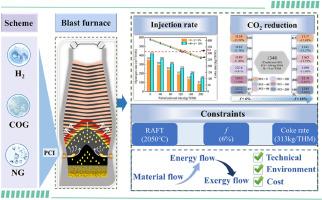高炉中富氢燃料喷射的材料和火用驱动的比较评估:可行性信封和碳减排
IF 9.4
1区 工程技术
Q1 ENERGY & FUELS
引用次数: 0
摘要
为了解决炼铁过程中脱碳的迫切需要,本研究研究了富氢燃料,包括氢(H2)、焦炉气(COG)和天然气(NG)与煤粉在高炉中的可持续共喷。在纳入Rist作业线的质能能综合平衡模型的基础上,建立了系统的评价模型。该模型能够在2050℃的临界滚道绝热火焰温度(RAFT)和合理的顶气温度下,协同评价技术指标和CO2减排,优化富氢燃料、煤粉和富氧比的匹配关系。在最佳工况下,H2、COG和NG的最大喷注速率分别为165、97和85 m3/THM,煤粉和H2共喷的最大减碳量为9.03%。与传统高炉相比,共喷H2、COG和NG的煤粉输入火用分别降低了7.11%、8.98%和12.47%,而高炉煤气输出火用分别增加了20.29%、17.28%和24.41%。此外,富氢高炉在能源效率和热力学完善度方面表现出良好的性能。然而,在富氢高炉中保持恒定的RAFT需要更高的火用输入。本研究为优化高炉富氢燃料喷注提供了定量框架,为实现低碳炼铁建立了脱碳路线图。本文章由计算机程序翻译,如有差异,请以英文原文为准。

Material and exergy-driven comparative assessment of hydrogen-rich fuels injection in blast furnaces: Feasibility envelope and carbon reduction
To address the urgent need for decarbonization in ironmaking, this study investigates the sustainable co-injection of hydrogen-rich fuels, including hydrogen (H2), coke oven gas (COG), and natural gas (NG) with pulverized coal into blast furnaces. Based on a comprehensive mass-energy-exergy balance model incorporating the Rist operation line, a systematic evaluation model has been developed. This model enables synergistic assessment of technical indicators, CO2 emission reduction, and optimization of the matching relationship among hydrogen-rich fuels, pulverized coal, and oxygen enrichment ratio at a critical raceway adiabatic flame temperature (RAFT) of 2050 °C and reasonable top gas temperature. Under optimal operating conditions, the maximum injection rates for H2, COG, and NG are determined to be 165, 97, and 85 m3/THM, respectively, while the maximum carbon reduction amount with pulverized coal and H2 co-injection reaches 9.03 %. In comparison to a traditional blast furnace, the input exergy of pulverized coal for H2, COG, and NG co-injection decreases by 7.11, 8.98 and 12.47 %, whereas the output exergy of blast furnace gas (BFG) increases by 20.29, 17.28 and 24.41 %, respectively. Furthermore, hydrogen-rich blast furnaces exhibit favorable performance in terms of energy efficiency and thermodynamic perfection degree. However, maintaining a constant RAFT in hydrogen-rich blast furnaces requires higher exergy input. This study provides a quantitative framework for optimizing the hydrogen-rich fuels injection in blast furnaces, establishing decarbonization roadmaps for achieving low-carbon ironmaking.
求助全文
通过发布文献求助,成功后即可免费获取论文全文。
去求助
来源期刊

Energy
工程技术-能源与燃料
CiteScore
15.30
自引率
14.40%
发文量
0
审稿时长
14.2 weeks
期刊介绍:
Energy is a multidisciplinary, international journal that publishes research and analysis in the field of energy engineering. Our aim is to become a leading peer-reviewed platform and a trusted source of information for energy-related topics.
The journal covers a range of areas including mechanical engineering, thermal sciences, and energy analysis. We are particularly interested in research on energy modelling, prediction, integrated energy systems, planning, and management.
Additionally, we welcome papers on energy conservation, efficiency, biomass and bioenergy, renewable energy, electricity supply and demand, energy storage, buildings, and economic and policy issues. These topics should align with our broader multidisciplinary focus.
 求助内容:
求助内容: 应助结果提醒方式:
应助结果提醒方式:


